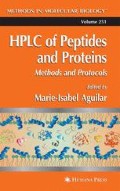Abstract
Venoms have attracted significant study in recent years as a reservoir of complex libraries of natural products possessing a wide range of biological activities. Moreover, venoms contain specific and potent molecules that may be utilized in pharmaceutical development and in the production of environmentally friendly insecticides. The compositions of venoms are typically highly complex and contain a variety of molecules including proteins, peptides, and numerous types of small molecules. This complexity requires highly sensitive techniques to allow separation of these components for study. The techniques should also be able to accommodate large variations in sample size to account for the differences in venom available from different creatures (e.g., some snakes can supply up to 500 mg of crude venom from a single milking, whereas some small insects, such as ants, supply submicrogram amounts [1]). These qualities have been found and continue to be advanced in the technique high-performance liquid chromatography (HPLC), in particular reversed-phase HPLC (RP-HPLC). This technique combined with a variety of detection methods can allow the collection of a significant amount of data from very small venom samples.
Access this chapter
Tax calculation will be finalised at checkout
Purchases are for personal use only
Notes
- 1.
*
Applied Biosystems homepage
References
Sutherland, S. K. and Tibballs, J. (2001) Australian Animal Toxins: The Creatures, their Toxins and Care of the Poisoned Patient. Second ed. Oxford University Press, South Melbourne, Australia.
Sheumack, D. D., Carroll, P. R., Hampson, F., et al. (1983) The isolation and N-terminal sequence of the lethal neurotoxin from the venom of the male Sydney Funnel-web spider. Atrax robustus. Toxicon. Suppl. 3, 397–400.
Collins, S. P., Comis, A., Tyler, M. I., Marshall, M., and Howden, M. E. H. (1995) Evidence for a high molecular weight pre-robustoxin molecule in the venom of the male Sydney funnel-web spider (Atrax robustus). Comp. Biochem. Physiol. 110C, 89–93.
Cain, T. C., Lubman, D. M., and Weber, W. J. J. (1994) Differentiation of bacteria using protein profiles from matrix-assisted laser desorption/ionization time-of-flight mass spectrometry. Rapid Commun. Mass Spectrom. 8, 1026–1030.
Chong, B. E., Wall, D. B., Lubman, D. M., and Flynn, S. J. (1997) Rapid profiling of E. coli proteins up to 500 kDa from whole cell lysates using matrix-assisted laser desorption/ionization time-of-flight mass spectrometry. Rapid Commun. Mass Spectrom. 11, 1900–1908.
Krishnamurthy, T. and Ross, P. L. (1996) Rapid identification of bacteria by direct matrix-assisted laser desorption/ionization mass spectrometric analysis of whole cells. Rapid Commun. Mass Spectrom. 10, 1992–1996.
Holland, R. D., Wilkes, J. G., Rafii, F., et al. (1996) Rapid identification of intact whole bacteria based on spectral patterns using matrix-assisted laser desorption/ionization with time-of-flight mass spectrometry. Rapid Commun. Mass Spectrom. 10, 1227–1232.
Liang, X., Zheng, K., Qian, M. G., and Lubman, D. M. (1996) Determination of bacterial protein profiles by matrix-assisted laser desorption/ionization mass spectrometry with high-performance liquid chromatography. Rapid Commun. Mass Spectrom. 10, 1219–1226.
Roda, A., Gioacchini, A. M., Seraglia, R., et al. (1997) A comparison of the analytical performance of sodium dodecyl sulfate-polycrylamide gel electrophoresis, electrospray and matrix-assisted laser desorption/ionization mass spectrometry in the study of the protein extract from Bothrops jararaca snake venom. Rapid Commun. Mass Spectrom. 11, 1297–1302s.
Jones, A., Bingham, J. P., Gehrmann, J., et al. (1996) Isolation and characterization of conopeptides by high-performance liquid chromatography combined with mass spectrometry and tandem mass spectrometry. Rapid Commun. Mass Spectrom. 10, 138–143.
Bingham, J.-P., Jones, A., Lewis, R. J., Andrews, P. R., and Alewood, P. F. (1996) Conus venom peptides (conopeptides): Inter-species, intra-species and within individual variation revealed by ionspray mass spectrometry, in Biochemical Aspects of Marine Pharmacology (Lazarovici, P., Spiro, M., Zlotkin, E., eds.), http://www.alaken.com., Alaken Inc., Ft. Collins, CO, pp. 13–27.
Krishnamurthy, T., Prabhakaran, M., and Long, S. R. (1996) Mass spectrometric investigations on Conus peptides. Toxicon. 34, 1345–1359.
Romi-Lebrun, R., Martin-Eauclaire, M. F., Escoubas, P., et al. (1997) Characterization of four toxins from Buthus martensis scorpion venom, which act on apamin-sensitive Ca2+-activated K+ channels. Eur. J. Biochem. 245, 457–464.
Escoubas, P., Celerier, M. L., and Nakajima, T. (1997) High-performance liquid chromatography matrix-assisted laser desorption/ionization time-of-flight mass spectrometry peptide fingerprinting of tarantula venoms in the genus Brachypelma—chemotaxonomic and biochemical applications. Rapid Commun. Mass Spectrom. 11, 1891–1899s.
Escoubas, P., Whiteley, B. J., Kristensen, C. P., Celerier, M. L., Corzo, G., and Nakajima, T. (1998) Multidimensional peptide fingerprinting by high performance liquid chromatography, capillary zone electrophoresis and matrix-assisted laser desorption/ionization time-of-flight mass spectrometry for the identification of tarantula venom samples. Rapid Commun. Mass Spectrom. 12, 1075–1084.
Escoubas, P., Chamot-Rooke, J., Stocklin, R., et al. (1999) A comparison of matrix-assisted laser desorption/ionization time-of-flight and liquid chromatography electrospray ionization mass spectrometry methods for the analysis of crude tarantula venoms in the Pterinochilus group. Rapid Commun. Mass Spectrom. 13, 1861–1868.
Sheumack, D. D., Baldo, B. A., Carroll, P. R., Hampson, F., Howden, M. E. H., and Skorulis, A. (1984) A comparitive study of properties and toxic constituents of funnel-web spider (Atrax) venoms. Comp. Biochem. Physiol. 78C, 55–68.
Siuzdak, G. (1996) Mass Spectrometry for Biotechnology. Academic, San Diego, CA.
Bingham, J. P. (1998) Novel Toxins from Conus: From Taxonomy to Toxins. University of Queensland, St. Lucia, Australia, p. 290.
Wilson, D. T. R. (2001) The Identification and Characterisation of Australian Funnel-web Spider Venom. University of Queensland, St. Lucia, Australia, p. 282.
Atkinson, R. K. and Wright, L. G. (1990) A study of the necrotic actions of the venom of the Wolf Spider, Lycosa Godeffroyi, on mouse skin. Comp. Biochem. Physiol. 95C, 319–325.
Author information
Authors and Affiliations
Editor information
Editors and Affiliations
Rights and permissions
Copyright information
© 2004 Humana Press Inc.
About this protocol
Cite this protocol
Wilson, D., Alewood, P. (2004). Australian Funnel-Web Spider Venom Analyzed With On-Line RP-HPLC Techniques. In: Aguilar, MI. (eds) HPLC of Peptides and Proteins. Methods in Molecular Biology™, vol 251. Springer, Totowa, NJ. https://doi.org/10.1385/1-59259-742-4:307
Download citation
DOI: https://doi.org/10.1385/1-59259-742-4:307
Publisher Name: Springer, Totowa, NJ
Print ISBN: 978-0-89603-977-3
Online ISBN: 978-1-59259-742-0
eBook Packages: Springer Protocols

